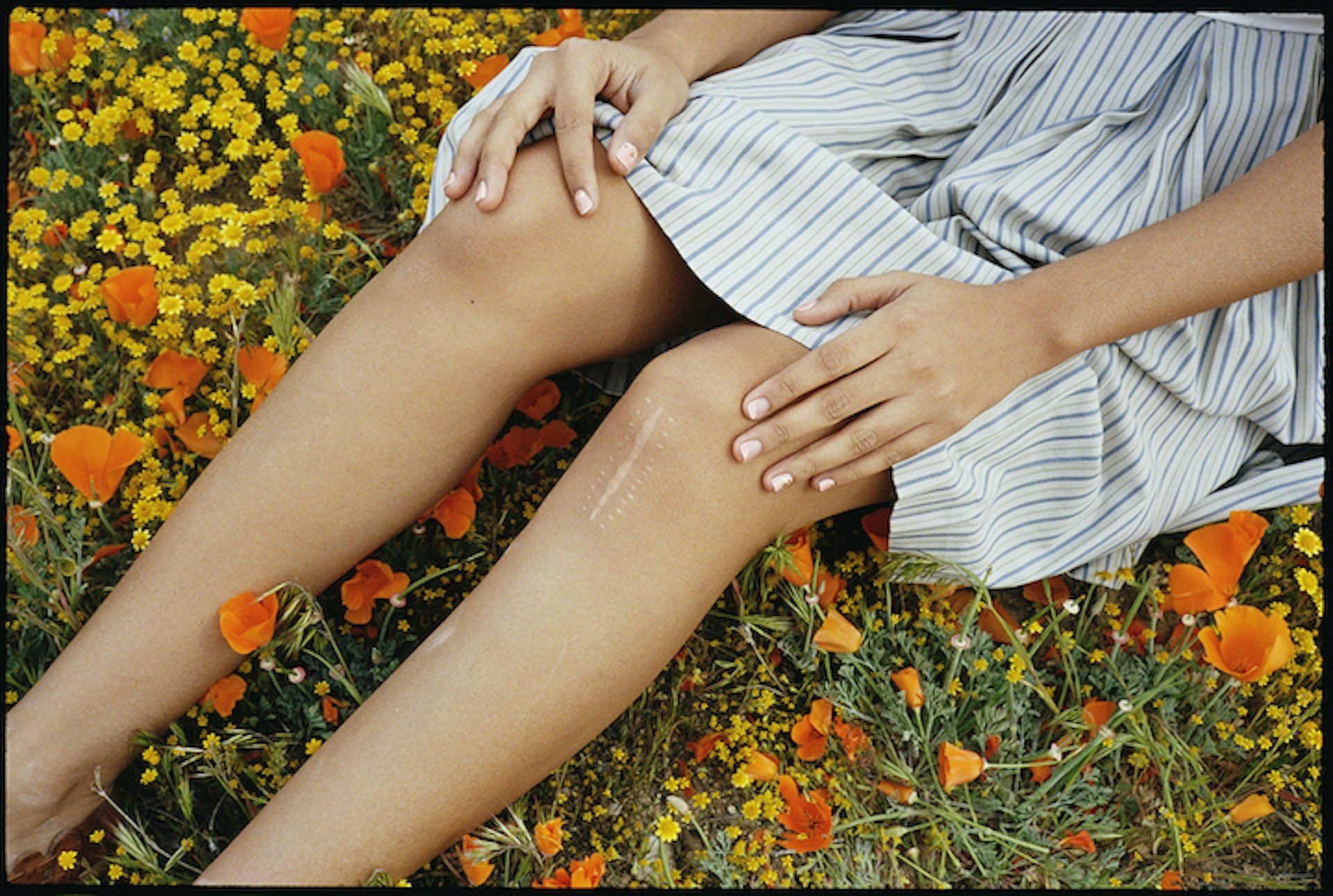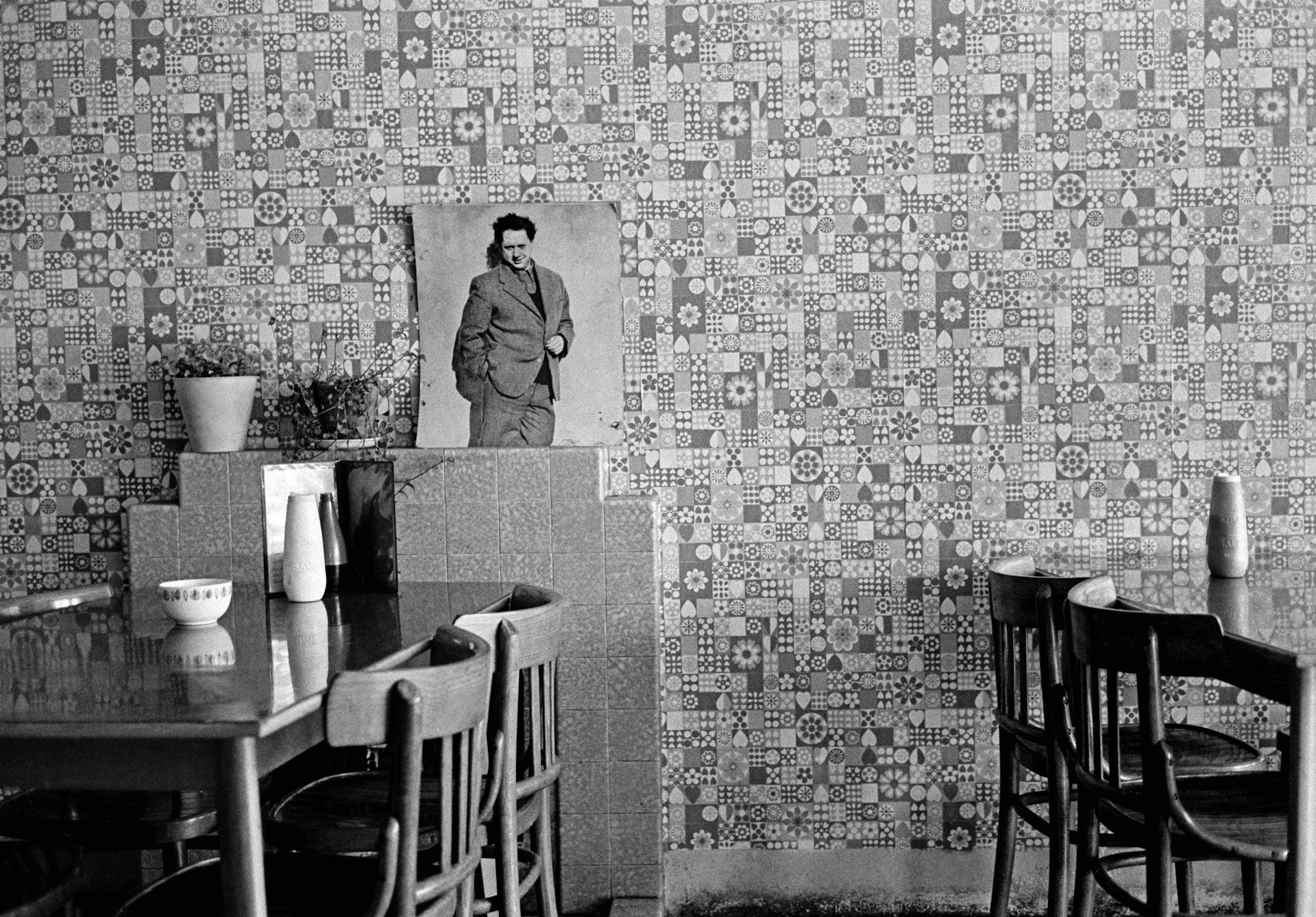
Dear young photographer: 'Shoot a lot of pictures. Be a doer, not a chatter.'
- Text by Andrea Kurland
- Photography by Various / Magnum Photos
Turning points can come like a bolt out the blue, in the most unlikely of places. In 1958, David Hurn was a young budding photographer, minding his own business on a self-assigned task, when his pivotal moment casually tapped him on the shoulder.
“I was photographing pigeons in Trafalgar Square,” says Hurn. “[A man] came up to me and said, ‘I think you might be a very good photographer – you can tell by the concentration people put into their pictures. Amateurs flit around: people who care concentrate.’”
The man turned out to be Sergio Larrain, the Chilean photographer whose energetic work had him touted as a rising star. That encounter, however casual, became a gateway to another world, one that Hurn would not only join but in turn help build over the next 60 years and counting.
Through Larrain, Hurn met John Hillelson, who worked as an agent for Magnum Photos. The staunchly democratic agency – founded in 1947 by Henri-Cartier Bresson, Robert Capa, George Rodger and David “Chim” Seymour – had established itself as a home for emerging talent. Hurn spotted an opportunity and dove right in.
“John was a guiding light to me,” he says. “When Magnum photographers came to London to see him, I said, ‘I’d like to be your assistant.’”
Over the years that followed, Hurn came to know and learn from some of the greatest photographers of the twentieth century – from Bruce Davidson and Elliott Erwitt to Cartier-Bresson himself – becoming a great photographer in his own right and eventually joining Magnum in 1967. Every photographer he met became a part of his own story – and he has a memento from each encounter to prove it.
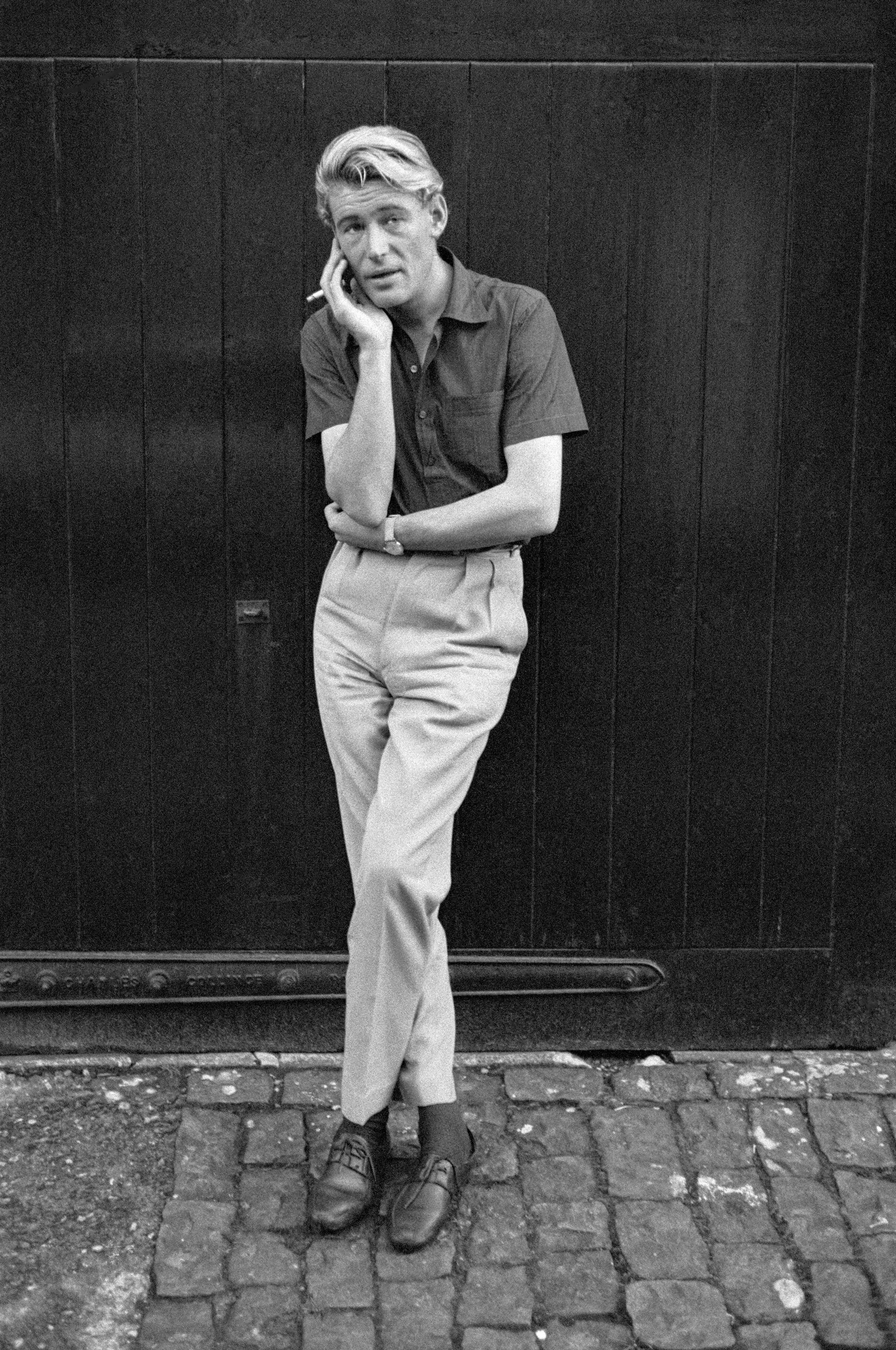
Peter O’TOOLE. Actor. British leading actor of both stage and film, 1962. Photo by David Hurn.
“I loved their pictures so much,” he says. “But people forget there were no photo galleries until 1968 in London, so the idea of having photographs as art was not on the table… As I became better known, and as the gallery scene started, I began to swap pictures with people.”
Hurn, 83, is hunched down low in his chair, chatting warmly over Skype from his cottage in Wales as if we were sharing the same pot of tea. There are shelves piled high with boxes and books and what appears to be a large-format printer, all crammed into the cosy confines of an office-like space that seems fit for a hobbit. In amongst these boxes, stored both here and elsewhere, lies a collection of over 700 prints – “a dozen Bressons, and people like Dorothea Lange” – that Hurn has amassed over a lifetime. To swap a print with David Hurn is the equivalent of hazing within Magnum – and something of a badge of honour: “It became tradition that [new members] would wait for me to say, ‘Can we swap a couple of prints.’”
On May 18, a sliver of this collection, curated by Martin Parr, will be unveiled at Photo London to celebrate the agency’s 70th anniversary. There’ll be founding fathers beside young nominees – Cartier-Bresson beside Diana Markosian.
It’s a rare outing for Hurn, whose will states that the collection must never be broken up or sold, and who sees himself as a custodian. (“I felt that as these pictures had been swapped, I was looking after them”). But also because, when viewed en masse, these prints carry the pockmarks of his own learning curve – the journey of a young upstart who got his big break shooting the decisive moment of a pigeon.
It sounds like the collection you’ve amassed chronicles your journey as a photographer. What have you learned along the way? One of the things I decided early on was that I wouldn’t just say, ‘Swap whatever you want.’ The collection is my choice: it has an authorship. Obviously, most of the photographers who were in it became friends, and when one does things seriously, you tend to make friends with other people who think seriously… There is something about ‘doers’ that they tend to congregate together and get on with each other, as opposed to ‘talkers’ who never do anything.
What I gained most from all of these relationships is the fact that whether they be a painter or whatever, if they’re doers, you get a terrific buzz out of it. You also begin to realise that doers work. They work their butts off. They finish things.
But you don’t learn anything from the images alone. Take Bruce Davidson. If I started to copy him that would be stupid because I wouldn’t be me. And if I wasn’t me, I would be second-division. You have to be yourself. But you can learn things like integrity and truth in conversation with various people – it’s almost as though you get a bottle of information. That’s what you learn most from.
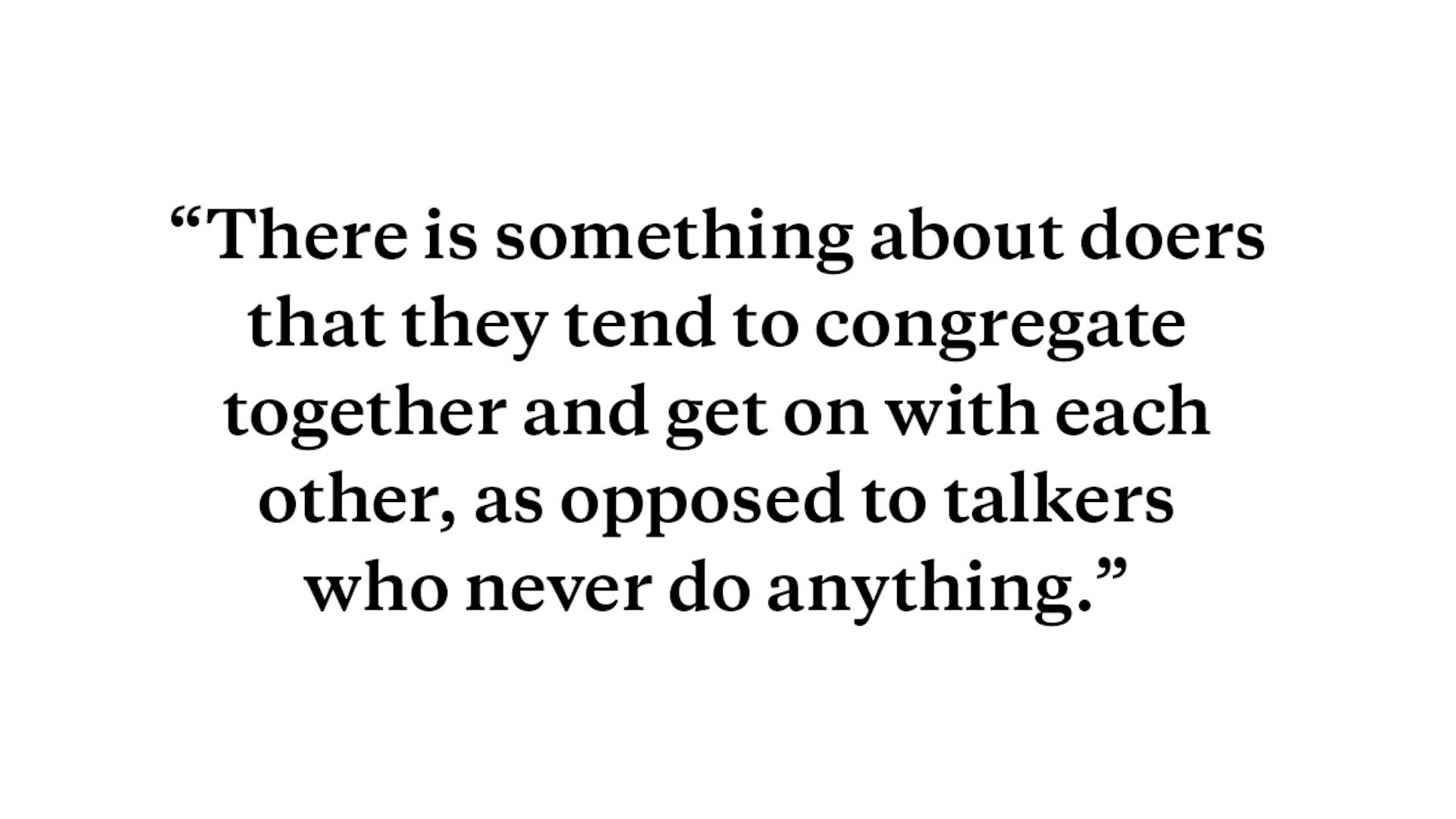
In the ’60s you frequented fantastic spaces where artists of all kinds would gather – coffee shops like The Nucleus on Shaftesbury Avenue. You also had your own flat, Porchester Court, that became a gathering place for photographers passing through London. How important were those spaces in bringing ‘doers’ together? Staggeringly important. When I first went up to London after the army, I sold shirts in Harrods to make some money. Every evening I would go to the coffee bars, they were just becoming a big thing, and I would photograph there. That was the first time I really understood the word networking because in these coffee bars I met people like [director] Ken Russell and [writer] Colin Wilson. I met Nell Dunn, who wrote Up the Junction. This is what I was saying – the doers.
The Nucleus was incredible because it came into its own after midnight. Musicians like Stan Tracey would congregate and play, so that was another entry into another world. The guy that owned, Gary Winkler, was a drummer and a chef, but all he did was spaghetti… All these places had their own ambience, but they were an incredible learning curve because it was so easy to get to people who were doing things.
How much do you look at social media and how emerging photographers interact today?
I’m not on Facebook or Twitter. If I need a friend I need to be able to smell them. But I have tried Instagram…. I’ve tried to do it as a semi-educational thing, like a photo tip of the month. I just find it a bit of a chore.
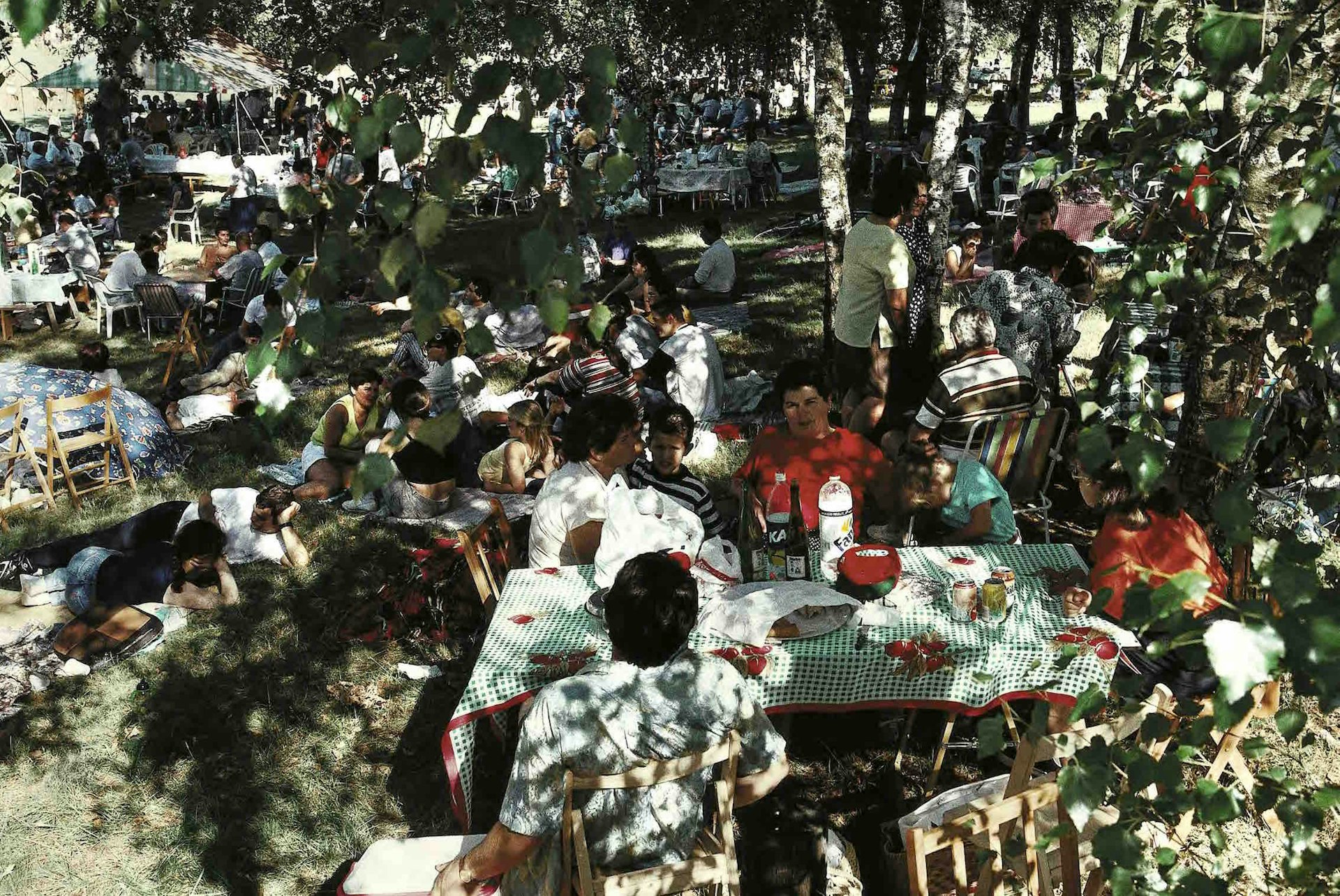
SPAIN. Extremadura. The Picnic, 1998. Photo by Harry Gruyaert.
Are you hopeful this generation can create their own real-life symposiums. Could somewhere like The Nucleus exist today? Well I wish it would because I think it’s enjoyable and productive. There were always people there – photographers, writers, actors – and they were all communicating. There’d be [Richard] Avedon and a picture editor having dinner together… Maybe I’m in a bubble, but I don’t see young photographers in Cardiff having dinner every two weeks to discuss subject matter, or what they’ve been having trouble with. I think that’s a shame.
If you sit down and suddenly there’s someone like Daniel Barenboim, the pianist, boy oh boy do you have something to talk about. How on earth does he play the piano? I remember going to watch him play a concert, and afterwards we went to have dinner. I was staring at him and he asked what I was thinking and I said: ‘I don’t understand how a human being can play a piano like you, it doesn’t seem real. What is the essence of being a concert pianist?’ He said, ‘You play the piano a lot.’
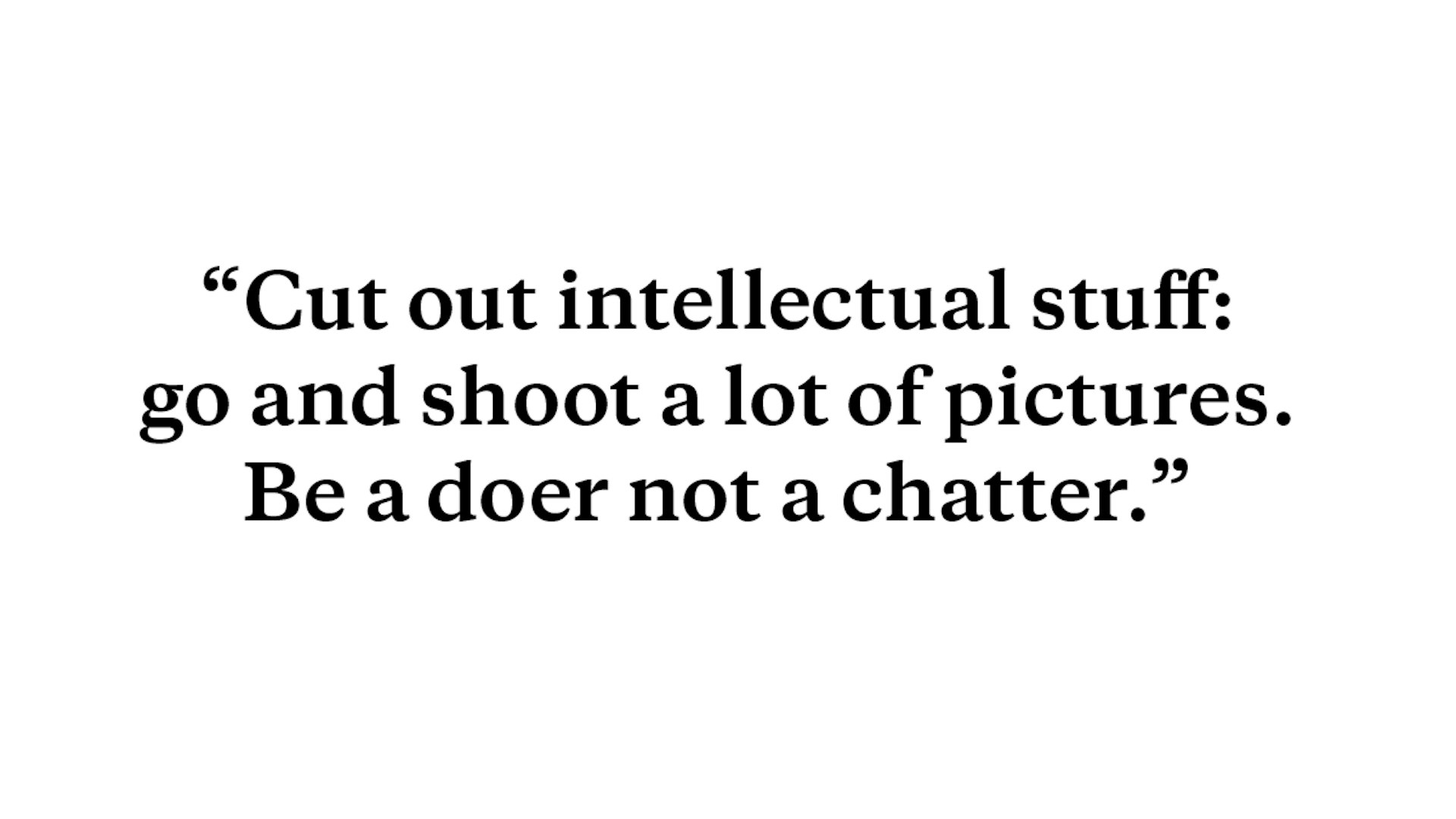
It’s the same with photography. It’s about trying to be an expert in whatever narrow bit of life you like – then learning how to encapsulate that in pictures. And then showing those pictures to someone else. You do that through meeting people, reading and research. It’s difficult but it’s enormous fun.
I read somewhere you once told students: “Learn from the best or teach yourself, and do not bother if you don’t have an exaggerated sense of curiosity.” Do you think it’s a good time to be a self-taught photographer, given that we can all access one another’s work? It is essential to have curiosity, that’s the starting point. Let’s pretend you’re a botanist. The important thing about being a botanical photographer is that you understand about botany – the photography comes afterwards. If you love plants, and say it would be nice to record them, very quickly you will become a good photographer of plants because you understand them.
But my feeling is, we are in a difficult time with education and it’s partly governed by how expensive university is. If you’re going to spend £30,000 I would question if that is the best approach. It might be if you want an academic conceptual background, fine. But my feeling is that the history of photography tells us the best photographers were either self-taught or, if they went to university, they didn’t do photography – they did history, politics, literature, and that their photography came as an extension of that. Basically photography is about taking lots of pictures and seeing if you do it well. Seeing if you have something to say which someone else thinks is interesting. Simple as that.
If I had a son what would I do? I would give him a round-the-world ticket for 6 months. I would say go and shoot lots of pictures around the world, come back and start to think what you enjoyed most while you were doing that process. Then I would say ok, if you find that you’re interested in social problems around the world, then do a workshop with someone who works with NGOs. If, on the other hand, you decide on landscapes, then go and do a workshop with Charlie Waite. I personally think that would be a better approach.
You did some groundbreaking work as the head of documentary photography at Newport, University of Wales, showing students how much planning has to go into a personal project. How did you come to that conclusion yourself? A lot of that goes way back to 1958, when I first had contact with the Magnum office. All the contact sheets of the great photographers were there and I used to spend literally every evening for hours looking at the sheets. You could see how much work went into a story or essay. They all had the same thing in common. They understood how to break down a complicated idea into its component visual parts. They shot in a different way of course; if you look at Cartier-Bresson’s work, you know it’s not Koudelka’s work… But you can see what they’re doing form their pictures. It’s simple.
Say you’re at a sheep dog trial. You know you need a picture of where it is. You need a picture of a man with his dog and sheep. You need a close-up of the farmer. If you jot these down on paper, then you can do whatever you like into that structure but at least it’s complete; you’re not inventing some sort of vague story that you thinks fits your pictures.
When you were looking at contact sheets, was it encouraging to you to see how many frames needed to be shot in order to find that one iconic image? These days people tend to show their best selves – and their best work – not the frames that never made it. I wonder if you had any advice for a photographer who feels downtrodden after a day of not getting that perfect image? I can tell you a true story. I was having a dinner with Cartier-Bresson and W. Eugene Smith. They were having a conversation and Bresson said, ‘How many great pictures do you think you take a year?’ And Eugene Smith, trying to sound modest, said ‘About 15.’ And Bresson said, ‘You always exaggerate.’
With everything else like painting, you start from nothing. And then you paint and if you get it wrong, paint over the top. Writing’s the same: if you don’t like it, cross it out. Photography’s the other way round. You start with a mess, and somehow you have to clarify that mess in a fraction of a second, that’s very difficult and most of the time you can’t do it. Take Cartier-Bresson, arguably the greatest photographer. Go through his contact sheets, maybe 10 contacts sheets, and there isn’t a picture marked up in that. These guys find it difficult. Perhaps that’s what makes it fun?
With young people, they seem to think everything they take is great. But they really aren’t going to compete, because to do it well is very, very difficult. You’ve got to be incredibly self-critical. There is a difference taking a selfie of a friend, which is charming and nice, but it isn’t quite the same.
What’s your advice for a young photographer who is not being self-critical? It’s difficult. My advice is to look at lots and lots of work by other photographers who you admire, and then try to analyse what it is those people do. Part of the thing is to do with authorship. If you know a little tiny bit about music, you will know the difference between Beethoven and Bach and say Delius. They have authorship. Now Delius when writing his music doesn’t say, ‘I’m writing like this because I don’t want to be like Beethoven.’ He just plays his music and that’s him. Rembrandt doesn’t look like Picasso, who doesn’t look like Matisse. You get the same in photography. And somehow the young photographer has got to absorb that idea and realise that what they have to do is follow their own interest.
That has a lot to do with what kind of subject matter you’re interested in. If you have a degree in botany, you’re going to shoot a lot of pictures of plants. If you’re interested in the way people react to each other, it’s difficult to find what among that is your point of view. But it is essential. You do it by shooting lots and lots of pictures of what you find interesting. With a bit of luck, over time, you will find a pathway that you begin to do, and once you find that then you’re away.
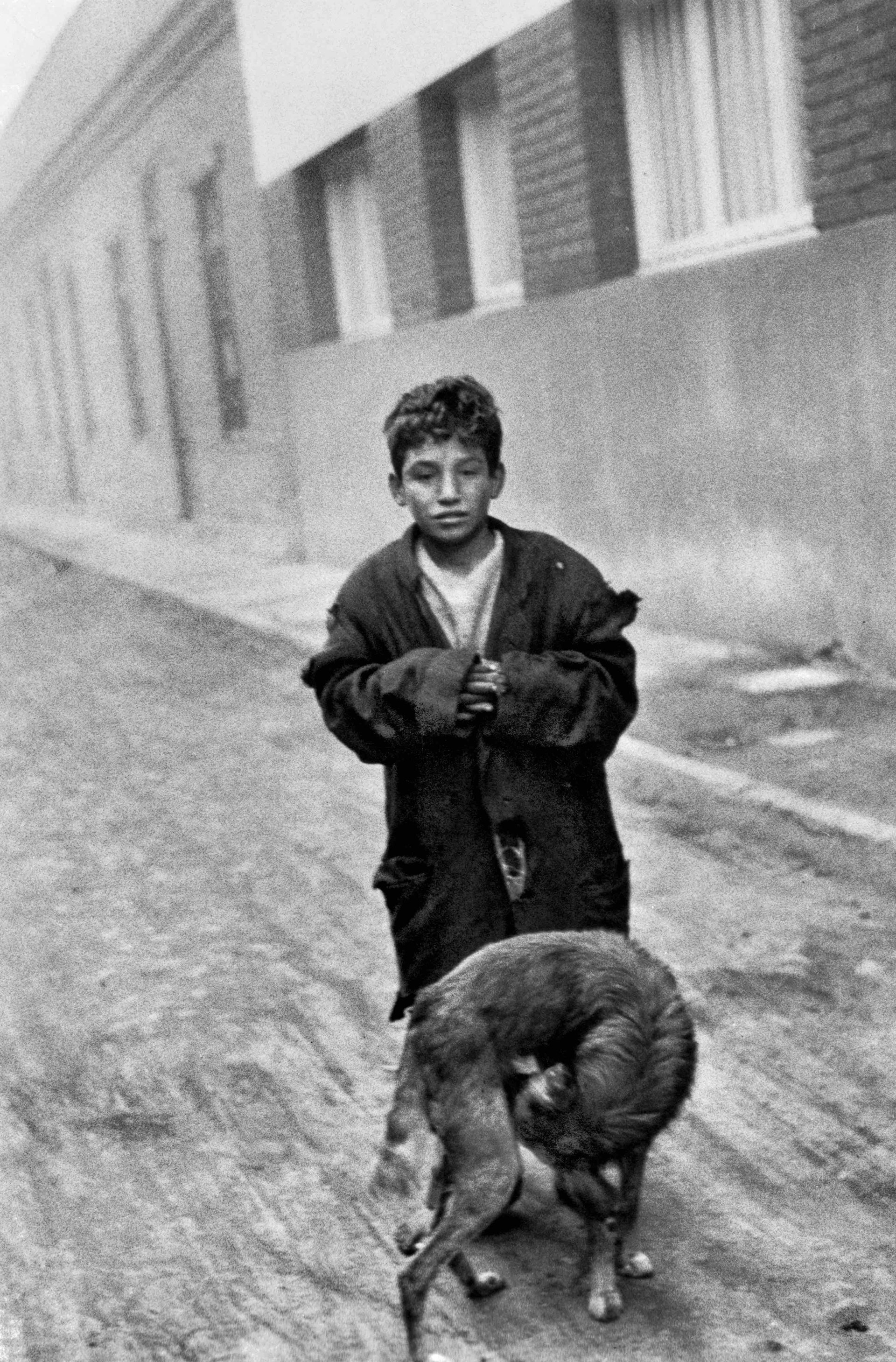
CHILE. Santiago, 1955. Photo by Sergio Larrain.
A lot of photographers have this added anxiety where they second-guess their own interests because they want to shoot something original. There’s a quest for newness, shooting what hasn’t been shot before. What’s your take on that? It’s irrelevant. Anything you shoot, somebody has shot before. But what they haven’t done is shoot it like you – if you are genuinely you. I keep going back to authorship. Almost by definition, tomorrow is different than today. If you go and photograph tomorrow, by definition you’re photographing something new. But this idea that you can artificially do something new is in my opinion total nonsense… Forget about that, just get on with it. Cut out intellectual stuff: go and shoot a lot of pictures. Be a doer not a chatter.
What advice would you have for a photographer who feels held back because they’re shy? I’m incredibly shy. Photography is the best thing for shy people because you have something to hide behind. The problem with shy people is that you don’t want to be rejected. So your safeguard is that you go into yourself. But with a camera, you have an excuse to be somewhere. So when you’re walking down the street and looking in a doorway at a whole load of people, being tattooed or something, with a camera you can walk in and suddenly say, ‘Do you mind if I shoot some pictures?’ And if you show a genuine interest in what people are doing, I have never known anyone to say no. People love you being interested in them. The camera gives you that excuse to be there. It breaks through that barrier.
Going back to that first encounter in Trafalgar Square – the fact that Larrain could tell that you were a photographer on an interesting journey. What are the common traits of a great photographer? Let’s pretend there was a news event going on which Ian Berry was shooting, I would say to the students: ‘Don’t take pictures of that event, just look at Ian Berry and follow him around.’ Because you will see the staggering concentration, and you will see how he pre-visualises where he ought to be next. So there’ll be a lot of people all photographing the same thing, then someone like Ian will have moved somewhere else. He’s going to be in the place where the person they’re photographing is going to go to. So if you’re photographing the Prime Minister, for example, Ian will pre-visualise where the person’s going. That’s experience.
What Sergio was saying is: if you see someone you like photographing, you will see how concentrated they are. If you see someone taking iPhone pictures, you’ll see how they flip around all the time. There is a real difference. I’m not against people shooting on their iPhone; they enjoy it, great, why not. But there is an enormous difference between shooting in a much more considered way.
Some people lament how ubiquitous image-making is today, and other people think that technology is a wonderful democratising force. Where do you sit on that spectrum? Are you excited by photography right now? For the first time, a form of communication that everyone likes seems to be photography. There’s never been a time when everyone liked drawing or writing. Now, suddenly, everyone’s got an iPhone. The problem is that they all shoot the same picture. It’s all to do with friends. That’s fine. The question is, can you move people a little tiny bit from there? I’m interested in trying to do that… I am not desperately worried by the fact people are shooting on their iPhones. But because of this interest in photography, perhaps you will get a few more people stretching themselves a little bit further, and maybe they will become good photographers.
I read you left education and started shooting more because you wanted to look back on your life and see yourself as a photographer and not a teacher, first and foremost. What does it mean to identify as a photographer? Photography for me does two things. One is that it brings back memories; I’m continually going back through my contact sheets. And I think as a method of recording history it’s wonderful. I like the idea that the pictures I shoot – mainly in Wales now, because I’m interested in my culture – will be a historic record of Wales at a particular time, 1970 to now. I think that’s useful. It lets people have an accurate idea of what life was like.
The thing about photography is you have to be there to do it. It’s not at the end of the phone. You physically have to be there. You have to meet people and talk to them. One of the things I think young people are missing out on is that interaction with people. I’ve just given a lecture up in Shrewsbury, and a lot of the questions were, ‘How do you take pictures of people?’ I kept saying, it’s easy: you just go up and shoot. But you can only do that if you’re not afraid of interacting with other human beings… I love that, sitting down and suddenly talking to the person next to me. If you can do that, it’s easy to photograph them… People love you taking notice of them. That’s what photography is about.
It seems you spent so much of life learning from other people. What advice do you return to in moments of self-doubt? I like the Lewis Hine quote: ‘What we should be photographing is that which we try to put right, and that which we appreciate.’ I like the [Michel de] Montaigne quote: ‘I myself am the matter of my book,’ which implies the essays he’s writing are his personality coming out. That’s what I think photographers should be doing: their pictures should be them. So those sort of quotes are in the back of my mind all the time. I also like [John] Updike: ‘The exotic of the mundane,’ which is very much me. That sums up the pictures I like taking, just of everyday life, which other people would think is incredibly mundane. For example in the village yesterday there was a get-together of cycling, all these people on their bikes. I love all that.
David Hurn’s Swaps runs at Photo London, Somerset House, May 18-21.
Enjoyed this article? Like Huck on Facebook or follow us on Twitter.
